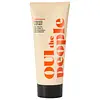What's inside
What's inside
 Key Ingredients
Key Ingredients

 Benefits
Benefits

 Concerns
Concerns

 Ingredients Side-by-side
Ingredients Side-by-side

Water
Skin ConditioningSodium Cocoyl Glycinate
CleansingGlycerin
HumectantSodium Lauroamphoacetate
CleansingAcrylates Copolymer
Cocamidopropyl Betaine
CleansingInulin
Skin ConditioningSodium Chloride
MaskingBenzyl Alcohol
PerfumingMyristic Acid
CleansingCocos Nucifera Fruit Extract
EmollientEthylhexylglycerin
Skin ConditioningMelaleuca Alternifolia Leaf Oil
AntioxidantSodium Gluconate
Skin ConditioningGlycol Stearate
EmollientLauric Acid
CleansingCaprylhydroxamic Acid
Lactobacillus Ferment
Skin ConditioningAvena Sativa Bran Extract
AbrasiveFructose
HumectantCocamidopropyl Dimethylamine
EmulsifyingLeuconostoc/Radish Root Ferment Filtrate
AntimicrobialEuterpe Oleracea Fruit Extract
Dimethylaminopropylamine
Linoleic Acid
CleansingOleic Acid
EmollientLinolenic Acid
CleansingWater, Sodium Cocoyl Glycinate, Glycerin, Sodium Lauroamphoacetate, Acrylates Copolymer, Cocamidopropyl Betaine, Inulin, Sodium Chloride, Benzyl Alcohol, Myristic Acid, Cocos Nucifera Fruit Extract, Ethylhexylglycerin, Melaleuca Alternifolia Leaf Oil, Sodium Gluconate, Glycol Stearate, Lauric Acid, Caprylhydroxamic Acid, Lactobacillus Ferment, Avena Sativa Bran Extract, Fructose, Cocamidopropyl Dimethylamine, Leuconostoc/Radish Root Ferment Filtrate, Euterpe Oleracea Fruit Extract, Dimethylaminopropylamine, Linoleic Acid, Oleic Acid, Linolenic Acid
Water
Skin ConditioningSodium C14-16 Olefin Sulfonate
CleansingSodium Cocoamphohydroxypropylsulfonate
CleansingSodium Lauroyl Methyl Isethionate
CleansingAloe Barbadensis Leaf
MaskingLactic Acid
BufferingOryza Sativa Hull Extract
MoisturisingDaucus Carota Sativa Extract
PerfumingCitrus Limon Peel Extract
EmollientIpomoea Batatas Root Extract
Skin ConditioningChondrus Crispus Extract
Skin ConditioningVaccinium Myrtillus Fruit Extract
Skin ConditioningCamellia Sinensis Leaf Extract
AntimicrobialLactobacillus Ferment Lysate
Skin ConditioningSaccharomyces Lysate
Skin ConditioningLithothamnion Calcareum Extract
Skin ConditioningPropanediol
SolventSodium Chloride
MaskingGlycerin
HumectantCocamidopropyl Pg-Dimonium Chloride Phosphate
Cocamidopropyl Betaine
CleansingCocamidopropyl Hydroxysultaine
CleansingCocamidopropyl Dimethylamine
EmulsifyingHydroxyacetophenone
AntioxidantSorbitan Caprylate
EmulsifyingSodium Methyl Oleoyl Taurate
CleansingSodium Cocoyl Isethionate
CleansingC10-16 Olefin
Caprylyl Glycol
Emollient1,2-Hexanediol
Skin ConditioningCitric Acid
BufferingTetrasodium Glutamate Diacetate
Maltodextrin
AbsorbentBenzoic Acid
MaskingSodium Benzoate
MaskingPotassium Sorbate
PreservativeParfum
MaskingLimonene
PerfumingLinalool
PerfumingWater, Sodium C14-16 Olefin Sulfonate, Sodium Cocoamphohydroxypropylsulfonate, Sodium Lauroyl Methyl Isethionate, Aloe Barbadensis Leaf, Lactic Acid, Oryza Sativa Hull Extract, Daucus Carota Sativa Extract, Citrus Limon Peel Extract, Ipomoea Batatas Root Extract, Chondrus Crispus Extract, Vaccinium Myrtillus Fruit Extract, Camellia Sinensis Leaf Extract, Lactobacillus Ferment Lysate, Saccharomyces Lysate, Lithothamnion Calcareum Extract, Propanediol, Sodium Chloride, Glycerin, Cocamidopropyl Pg-Dimonium Chloride Phosphate, Cocamidopropyl Betaine, Cocamidopropyl Hydroxysultaine, Cocamidopropyl Dimethylamine, Hydroxyacetophenone, Sorbitan Caprylate, Sodium Methyl Oleoyl Taurate, Sodium Cocoyl Isethionate, C10-16 Olefin, Caprylyl Glycol, 1,2-Hexanediol, Citric Acid, Tetrasodium Glutamate Diacetate, Maltodextrin, Benzoic Acid, Sodium Benzoate, Potassium Sorbate, Parfum, Limonene, Linalool
 Reviews
Reviews

Ingredients Explained
These ingredients are found in both products.
Ingredients higher up in an ingredient list are typically present in a larger amount.
Cocamidopropyl Betaine is a fatty acid created by mixing similar compounds in coconut oil and dimethylaminopropylamine, a compound with two amino groups.
This ingredient is a surfactant and cleanser. It helps gather the dirt, pollutants, and other impurities in your skin to be washed away. It also helps thicken a product and make the texture more creamy.
Being created from coconut oil means Cocamidopropyl Betaine is hydrating for the skin.
While Cocamidopropyl Betaine was believed to be an allergen, a study from 2012 disproved this. It found two compounds in unpure Cocamidopropyl Betaine to be the irritants: aminoamide and 3-dimethylaminopropylamine. High-grade and pure Cocamidopropyl Betaine did not induce allergic reactions during this study.
Learn more about Cocamidopropyl BetaineCocamidopropyl Dimethylamine comes from the fatty acids of coconut oil. It is an emulsifier, meaning it helps stabilize and mix ingredients.
This ingredient can be irritating in higher amounts and is related to Cocamidopropyl Betaine.
Glycerin is already naturally found in your skin. It helps moisturize and protect your skin.
A study from 2016 found glycerin to be more effective as a humectant than AHAs and hyaluronic acid.
As a humectant, it helps the skin stay hydrated by pulling moisture to your skin. The low molecular weight of glycerin allows it to pull moisture into the deeper layers of your skin.
Hydrated skin improves your skin barrier; Your skin barrier helps protect against irritants and bacteria.
Glycerin has also been found to have antimicrobial and antiviral properties. Due to these properties, glycerin is often used in wound and burn treatments.
In cosmetics, glycerin is usually derived from plants such as soybean or palm. However, it can also be sourced from animals, such as tallow or animal fat.
This ingredient is organic, colorless, odorless, and non-toxic.
Glycerin is the name for this ingredient in American English. British English uses Glycerol/Glycerine.
Learn more about GlycerinChances are, you eat sodium chloride every day. Sodium Chloride is also known as table salt.
This ingredient has many purposes in skincare: thickener, emulsifier, and exfoliator.
You'll most likely find this ingredient in cleansers where it is used to create a gel-like texture. As an emulsifier, it also prevents ingredients from separating.
There is much debate on whether this ingredient is comedogenic. The short answer - comedogenic ratings don't tell the whole story. Learn more about comegodenic ratings here.
The concensus about this ingredient causing acne seems to be divided. Research is needed to understand if this ingredient does cause acne.
Scrubs may use salt as the primary exfoliating ingredient.
Learn more about Sodium ChlorideWater. It's the most common cosmetic ingredient of all. You'll usually see it at the top of ingredient lists, meaning that it makes up the largest part of the product.
So why is it so popular? Water most often acts as a solvent - this means that it helps dissolve other ingredients into the formulation.
You'll also recognize water as that liquid we all need to stay alive. If you see this, drink a glass of water. Stay hydrated!
Learn more about Water